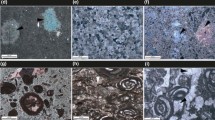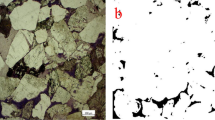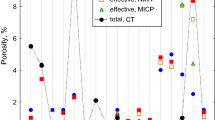Abstract
Porous carbonates display some of the most complex porosity networks in reservoir rocks. This requires a quantitative geometric description of the complex (micro)structure of the rocks. Modern computer tomography techniques permit acquiring detailed information concerning the porosity network in three dimensions. These datasets allow a more objective pore classification based on mathematical parameters. In this study, ratios of the longest, intermediate, shortest dimensions and compactness of the pore shapes, based on an approximating ellipsoid, are analysed to obtain a thorough and objective description of pore shapes. Using intrinsic properties of the latter, the classification can be used at every resolution scale. Five shape classes are defined: rod, blade, plate, cuboid and cube. An additional advantage of this classification is that the data provide information about the orientation of the pores. This allows assessing the anisotropy of the porosity parameter. Apart from having an objective pore-type classification, analysing the shape and orientation of the pores permits to study the relationship with other important petrophysical rock characteristics such as permeability, acoustic properties and rock mechanical behaviour.













Similar content being viewed by others
References
Ahr W (2011) Geology of carbonate reservoirs: the identification, description, and characterization of hydrocarbon reservoirs in carbonate rocks. Wiley, New York
Archie GE (1952) Classification of carbonate reservoir rocks and petrophysical considerations. AAPG Bull 36(2):278–298
Blott SJ, Pye K (2008) Particle shape: a review and new methods of characterization and classification. Sedimentology 55(1):31–63
Canny J (1986) A computational approach to edge detection. IEEE Trans Pattern Anal Mach Intell PAMI–8(6):679–698
Choquette P, Pray L (1970) Geologic nomenclature and classification of porosity in sedimentary carbonates. Am Assoc Pet Geol Bull 54(2):207–250
Claes H, Soete J, Van Noten K, El Desouky H, Marques Erthal M, Vanhaecke F, Özkul M, Swennen R (2015) Sedimentology, three-dimensional geobody reconstruction and carbon dioxide origin of Pleistocene travertine deposits in the Ballik area (south-west Turkey). Sedimentology 62:1408–1445
Cnudde V, Boone MN (2013) High-resolution X-ray computed tomography in geosciences: a review of the current technology and applications. Earth Sci Rev 123:1–17
Dobkins JE Jr, Folk RL (1970) Shape development on Tahiti-nui. J Sediment Petrol 40(4):1167–1203
Gonzalez RC (1987) Digital image processing. Addision-Wesley Publishing Company, Reading
Haralick RM, Shapiro LG (1991) Glossary of computer vision terms. Pattern Recognit 24 No 1(1):69–93
Kak AC, Slaney M (1989) Principles of computerized tomographic imaging. IEEE Press, New York
Keary P (2001) The new Penguin dictionary of geology. Penguin Books, London
Krumbein WC (1941) Measurement and geological significance of shape and roundness of sedimentary particles. J Semmentary Petrol 11(1):64–72
Lønøy A (2006) Making sense of carbonate pore systems. AAPG Bull 90(9):1381–1405
Lucia FJ (2007) Carbonate reservoir characterization: an integrated approach. Springer Science & Business Media, New York
Lucia FJ (1995) Rock-fabric/petrophysical classification of carbonate pore space for reservoir characterization 1. AAPG Bull 9(9):1275–1300
Meyer F (1994) Topographic distance and watershed lines. Signal Process 38(1):113–125
Moore CH (2002) Carbonate reservoirs porosity evolution and diagenesis in a sequence stratigraphic framework. Elsevier, Amsterdam
Nurmi R, Standen E (1997) Carbonates: the inside story. Middle East Well Eval Rev 18:28–41
Pentecost A (2005) Travertine. Springer Science & Business Media, Berlin
Sant’Anna LG, Riccomini C, Rodrigues-Francisco BH, Sial AN, Carvalho MD, Moura CAV (2004) The Paleocene travertine system of the Itaboraí basin, Southeastern Brazil. J South Am Earth Sci 18(1):11–25
Scholle P, Ulmer-Scholle D (2003) A color guide to the petrography of carbonate rocks: grains, textures, porosity, diagenesis, AAPG
Seber GAF (1984) Multivariate observations. Wiley, New York
Soete J, Kleipool LM, Claes H, Claes S, Hamaekers H, Kele S, Özkul M, Foubert A, Reijmer JJG, Swennen R (2015) Acoustic properties in travertines and their relation to porosity and pore types. Mar Pet Geol 59:320–335
Tucker ME, Wright VP (1990) Carbonate mineralogy and chemistry. In: Carbonate sedimentology. Blackwell Publishing Ltd., Oxford. doi:10.1002/9781444314175.ch6
Verwer K, Eberli G, Baechle G, Weger R (2010) Effect of carbonate pore structure on dynamic shear moduli. Geophysics 75(1):E1
Warren J (2000) Dolomite: occurrence, evolution and economically important associations. Earth Sci Rev 52(1–3):1–81
Wentworth CK (1923) The shapes of beach pebbles, US Goverment Printing Office
Wightman FL, Kistler DJ (1989) Headphone simulation of free-field listening. II: Psychophysical validation. J Acoust Soc Am 85(2):868–878
Wirjadi O (2007) Survey of 3D image segmentation methods. ITWM, Kaiserslautern
Wright VP, Barnett AJ (2015) An abiotic model for the development of textures in some South Atlantic early Cretaceous lacustrine carbonates Cretaceous. Geol Soc London Spec Publ 418(2012):1–11
Acknowledgments
The authors wish to acknowledge the Fund for Scientific Research—Flanders (FWO) for providing a Research Grant to the first author as well as the Hercules foundation (Flanders) for founding the micro- and nano-CT project for the hierarchical analysis of materials as well as the staff of the radiology department of UZ Leuven. Finally we would like to thank the reviewers for their constructive comments.
Author information
Authors and Affiliations
Corresponding author
Rights and permissions
About this article
Cite this article
Claes, S., Soete, J., Cnudde, V. et al. A three-dimensional classification for mathematical pore shape description in complex carbonate reservoir rocks. Math Geosci 48, 619–639 (2016). https://doi.org/10.1007/s11004-016-9636-z
Received:
Accepted:
Published:
Issue Date:
DOI: https://doi.org/10.1007/s11004-016-9636-z




